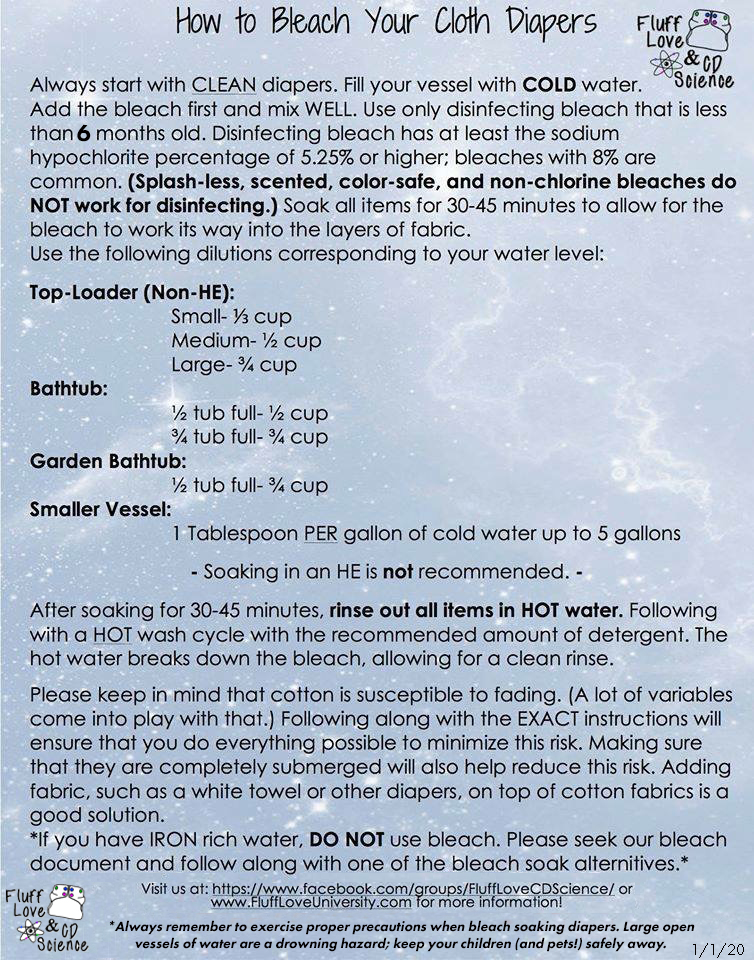Home >> Troubleshooting >> Solving Stinky Diaper Problems >> How to BLEACH Your Cloth Diapers
Start with CLEAN cloth diapers, using disinfecting bleach with at least 5.25% sodium hypochlorite as the active ingredient. Soak for at least 30 minutes (and not to exceed 45 min.) in COLD water using the following dilution corresponding to your load size:
Top Loader (Non-hE):
Small: 1/3 cup
Medium: 1/2 cup
Large/XL: 3/4 cup
Average Bathtub:
1/2 full: 1/2 cup
3/4 full: 3/4cup- 1cup
*Note* Measure from the top of the tub, regardless of where the overflow is.
Smaller Vessel:
1 Gallon: 1 Tablespoon For each gallon of cold water (up to 5 gal), add 1 Tbs. bleach.
*Note* Concentrated bleach requires the same dilution amounts.
Splash-less and scented bleaches DO NOT work for disinfecting.
After bleaching, rinse with HOT water, and follow with a HOT wash with detergent to completely break down the bleach.
*Note: You cannot soak in an hE Front-loader and soaking in a hE Top-loader is NOT recommended, you must use the bathtub or another container.
*Note: When rinsing, a rinse cycle in some hE (High Efficiency) washers will not always immediately deactivate the bleach. Always rinse HOT *in the tub* before transferring to a hE washer. If you are worried about a special diaper fading, please make sure you rinse carefully by hand and Do NOT WRING out any non-colorfast items prior to fully rinsing, this has the potential to cause fading.
If you are doing a bleach *WASH* instead of a bleach soak (as the follow-up for yeast treatment) you use the same amounts given above for the corresponding load size and wash in HOT water so that the bleach is broken down by the end of the wash cycle. If you’d like to do a bleach wash in an hE Front-loader, do so in a dispenser you have tested and trust and use the amounts given for an hE TL.
You will need to do a bleach soak to fully neutralize ammonia and kill built-up bacteria. Be sure that your bleach has disinfecting instructions on the bottle and says, “kills flu virus” and that it’s less than 6 months old. Bleach does expire!
If you have hard water, you may need to do a hard mineral strip prior to bleaching. Hard water leaves mineral deposits around your sinks and faucets. Check out our page on how to do a mineral strip.
If you have IRON hard water, do NOT use bleach
Use Borax/Peroxide in a tub soak
Average Bathtub:
1/2 full: 1 cup of Borax and 4 cups of Peroxide
Start with CLEAN cloth diapers, soak for at least 30 minutes (and not to exceed 45 min.) in COLD water, rinse in HOT water, and follow with a HOT wash with detergent. It isn’t as good as bleach, but it’s the best alternative. Iron Hard water leaves hard orange deposits around your water sources. This does run the same risk as bleach as far as fading and “staining” goes, so its not a better substitute for bleach. You should only be using borax/peroxide mix if you have iron rich water.
To test to see if you have iron hard water, put a drop of bleach in a cup of water and add a scrap of white fabric, like an old white sock. Let the fabric soak for 15 minutes and then rinse thoroughly. If the fabric turns orange, don’t use bleach. It will dye your diapers orange. If you’re bleaching because of ammonia/barnyard smells, after the soak is done, you need to adjust your wash routine. Increase the amount of detergent or add a water softener like Calgon or Borax if you have hard water.
Sometimes, multiple washes are necessary following a bleach soak, especially if the soak is following a strip. You may possibly experience a short-term decrease in absorbency of the diapers or skin irritation due to all of the impurities the bleach brings to the surface. Several good washes (average 2-4) with a proper detergent should fix any issues. You may need a stronger detergent. Powdered detergents work better than liquid because they have more built in water softeners in them, and most of the Americas have hard water to some degree. Powder also rinses cleaner than liquid.
Be sure you are using the appropriate water amount for your load size. Don’t let the diapers swim around freely if you have a top loader, it needs to look like a diaper stew in there so that the diapers can rub each other and let the friction help clean them. If it looks like a soup, it’s too much water, if it looks like a chili, it’s packed too tight and the diapers will move in a block—that’s too little water. You want a diaper stew. If you have a front loader, use whatever setting gives you the hardest agitation for the longest amount of time.
Proper detergent amount, water softeners if necessary, and proper load size should keep you from needing to bleach again.
A properly diluted bleach soak will not harm your diapers. You can bleach any fabric except for wool or silk. Polyester and PUL are colorfast, so there will not be any fading. SOME cotton prints MAY fade slightly, but it’s better to have a faded diaper than one that cannot be worn. Many have bleached a dark cotton outer to a bamboo fitted and had no fading at all.
Many manufacturers recommend bleaching as necessary. Keep in mind that properly cleaned diapers will not need to be bleached except if they were bought used or exposed to yeast infections, ringworm, staph infection, or any other infection that can be passed through fecal matter/urine.
Bleaching with septic systems is fine in moderation. “Disinfectants are considered safe for both septic systems and groundwater as long as they are used in concentrations listed on the product labels. For example, more than 2 gallons of hypochlorite bleach or 5 gallons of pine cleaner would be needed to kill most of the bacteria in a 1,000- gallon septic tank. It would then take 45-60 hours for the bacterial populations to recover from a lethal dose of hypochlorite bleach, and 30-65 hours to recover from a lethal dose of pine cleaner.
Additional concerns have been expressed regarding the fate of hypochlorite bleach in the septic tank. Under normal conditions of household use, the majority (97 percent to 99 percent) of sodium hypochlorite reacts with soils, stains, and organic solids in the wastewater to form salts and other harmful compounds. The remaining 1 percent to 3 percent of sodium hypochlorite entering a septic tank forms chlorinated compounds. Current research shows that the majority (87 percent to 94 percent) of these chlorinated compounds are degraded or removed by septic systems. As a result, the formation of chlorinated compounds from the normal use of hypochlorite bleach is not considered a threat to human health or the environment.”
http://waterquality.cce.cornell.edu/publications/CCEWQ-16-HouseholdChemicalsSeptic.pdf

To read up on Bleach for Sanitizing Safely:
